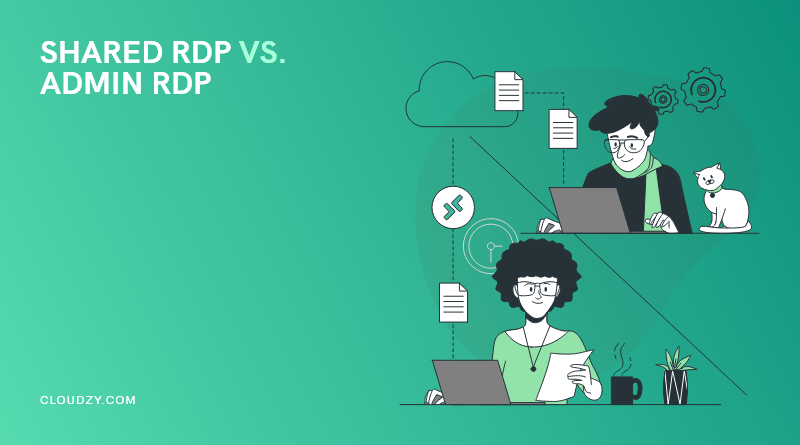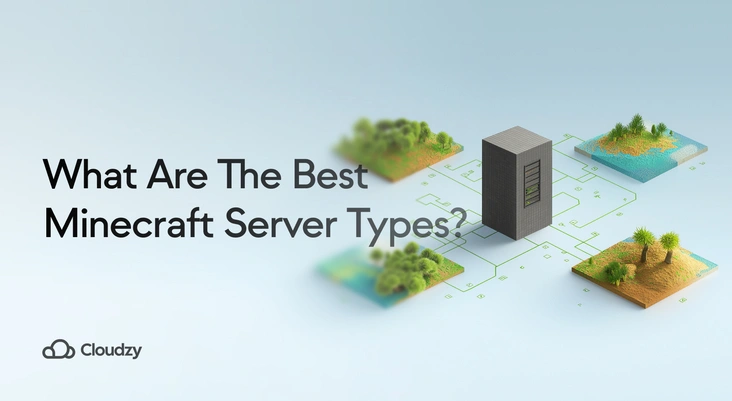So, you have decided that you need to get yourself an RDP server. RDP is by no definition a new technology, and it has been around for many years since its introduction by Microsoft. However, RDP’s inherent quality of establishing a connection between two computers makes it a rather touchy subject in the tech world. This distanced connection can lead to problems such as potential security breaches, data malfunction, etc.
So it’s important to evaluate RDP and its properties as a whole before making a decision on whether or not you are going to use one. One of the more important questions that need to be addressed before buying an RDP is if you are going for a shared RDP or an Admin RDP. This Shared RDP vs. Admin RDP dilemma often escapes newer users entirely, and only when they have paid for their precious RDP do they realize that maybe they need to consider the question before buying it. It’s also important to know that the difference between these two plans is not just technical. In almost all online stores where RDPs are sold, shared RDP is among the cheapest plans, while an admin RDP is much more pricey and often the most expensive service on the list. So now we will go over each of these RDP services to evaluate cost efficiency for either of them and try to settle the Shared RDP vs. Admin RDP debate for you.
What is an RDP?
Before actually going through with comparing these two different RDP connections, we have to take into account that maybe for some users, RDP is an entirely new concept. So here we’ll go over the definition of RDP as well as its two primary variants. We published an article solely to answer the question: What is an RDP? You can check that out first and comeback to this comparison if you want to understand the fundamentals, and if you already know what an RDP is, you can skip this part!
RDP stands for Remote Desktop Protocol, and as the name suggests, it is a system protocol that provides users with a graphical user interface through which they can take control of another computer that is connected with the first computer through RDP. While the original RDP was released in 1996 on Windows NT, it has grown to be included on many other operating systems. These, of course, include Android, IOS, MAC OS, and Linux, among others. Now that we got the basic RDP definition right let’s move on to see what is a shared RDP and an admin RDP.
If you already have two functioning machines that you want to establish an RDP link between, then this guide will be useful. This article is mainly aimed at comparing different RDP connections. For a more detailed explanation, you can visit here.
What is a Shared RDP?
When you buy a shared RDP service, you get a chunk of a server to your name. Now this server as a whole is shared between you and many other users that also have a shared RDP subscription on that server. You rarely have control over who you share the server with as the number of these people is determined by the service provider, while the distribution of the users is often random.
A significant drawback of shared RDP is the overload. If a certain user begins to excessively use the resources of the server, it will directly affect others who share the server with them. However, this sharing scheme also has benefits. For example, being equally shared, it rarely needs a manager to manage the server, and the maintenance is reduced to the bare minimum. Overall, shared RDP is among the cheapest services you can get. For the little you pay, you get faster computing and network speed than most conventional servers, but your total access is limited. A shared RDP is decent for those who are looking for a basic RDP to perform basic tasks on.
What is an Admin RDP?
Admin RDP, also known as Dedicated RDP, allows a user to attain administrator rights. This will allow the client to perform executive tasks on the server that shared users can’t. The allocated size of this server is also much larger. The client who purchases an admin RDP also doesn’t have to worry about sharing the resources with others as the server’s resources are exclusively reserved for them.
The Advantages don’t end there, as dedicated RDP comes with much higher-end CPU, Storage, and RAM specifications. While generally, the base plan of Admin RDPs is sufficient even for the greediest of developers, they can usually choose to upgrade it even further depending on their needs. An Admin RDP client gets a number of special privileges. These include the installation and uninstallation of programs, rebooting the server, partitioning, data relocation, and changing credentials. They can also choose to integrate their own security firewalls and customize the server to their heart’s desires. In other words, for the extra money they pay, they get a server that is essentially their own for the duration of the subscription.
 Need a Remote Desktop?
Need a Remote Desktop?
Reliable, high-performance RDP servers with 99.95 uptime. Take your desktop on the go to all the major cities in the US, Europe, and Asia.
Get an RDP ServerShared RDP vs. Admin RDP: The Showdown
While, by default, this contest is a bit of a David vs. Goliath scenario, it’s still worthwhile to compare these two RDP connections in a head-to-head contest to see exactly how they differ in each category. The fun thing here is that Shared RDP doesn’t actually need to win the majority of these categories to be a reliable option for you. While on the other hand, those who are developers and computer experts will lean towards admin RDP. We are going to compare these two RDP connections in six different categories, and in the end, we’ll come back to make a summary of which one is best for you.
Shared RDP vs. Admin RDP: Access Level
We start with the category that is reflected in the name of the RDPs as well. Right out of the gate, you should know that shared RDP does not grant you any administrator-level access and permission at all. Any meaningful change that you may want to perform has to go through the responsible admin or developer. In other words, you are somewhat limited to the basic setup that the RDP provider grants you and can’t make much change once you have it. These include basic tasks such as installing programs as well.
An admin RDP, on the other hand, comes with the full set. As the client, you’ll have full admin privileges and can change and customize your server as much as you need. Install and uninstall features and even change the system’s OS. This increased level of access will save you a lot of time as you can take responsibility for the running of the server as you like and do not have to rely on server managers for every little change that you want to make.
Today, we will go over these RDP services to evaluate cost efficiency for each of them and try to settle the Shared RDP vs. Admin RDP debate for you.
🏁It’s evident that an admin RDP clearly beats a shared RDP in this category, taking costs into consideration, of course.
Shared RDP vs. Admin RDP: Costs
Here comes the trickster factor that often sways a lot of newer users to go for a shared RDP without actually bothering to read its specifications. By far, the biggest determining factor in the Shared RDP vs. Admin RDP is the costs. A shared RDP will often be much cheaper compared to an admin RDP. However, this power comes at the price of several deficiencies. First, the host has no obligation to provide you with proper security. Second. As you share a shared RDP server, you are also sharing its CPU, RAP, and other properties. As already mentioned, a user’s heavy use can overload the server for others who share it. In other words, it’s cheap for you because it’s also cheap for the provider.
In an admin RDP, by contrast, you get your own exclusive set of hardware, including CPU, RAM, and much larger storage units. While you’re on an admin RDP, no one else is going to share it with you, and your IP address will also be unique. All of this may sound really good, and they are. If, of course, you are willing to pay up to 3 or 4 times the price of a shared RDP.
🏁No doubt, shared RDP is cheaper and should be considered the winner in a pure contest. However, since costs and privileges are relative, we’ll call this one a draw.
Shared RDP vs. Admin RDP: IP Management
Speaking of IP addresses, let’s address the elephant in the room. Since everything is shared in a shared RDP, as the name itself implies, the IP address is no exception. You will share the IP address of the server you’re on with all the other users on it, which will lead to several problems. First, all the websites that use IP addresses to create personalized experiences will not only do that for you but for all the other users. You will essentially be sharing your online identity with a bunch of other people, so you can pretty much forget about a personalized experience on a shared RDP.
On the other hand, an admin RDP will offer each and every single client an exclusive IP address that will not be shared or used by any other users. You can use this IP to greatly diversify and personalize your online experience. Since the misuse of an IP address by shared users can also compromise your security, a dedicated IP address will also increase your online security and can deal with much higher traffic volumes compared to shared IP addresses.
🏁Last but not least, your online standing and admittance to different websites will also be greatly increased with a unique IP address. Admin RDP is the clear winner.
Shared RDP vs. Admin RDP: Security
Let’s go for a quick hot potato hand-to-hand with the most important comparison factor between shared RDP and admin RDP. As already mentioned, the shared IP address already makes shared RDPs considerably weaker in security right from the get-go. Other aspects are also disappointing. Since you can’t modify your server’s security because of a lack of admin privileges, reliable security is almost completely off the table. Your security is limited to the server host provider checking in to evaluate security whenever their policy dictates. Between these checking intervals, you are completely exposed to any potential breach that may happen.
An admin RDP can choose any security tool that they wish to use at any time. Not only can you enjoy your dedicated IP address that eliminates the chance of exposure to other users’ activities, but you can also install any firewall that you wish and even use VPNs to further mask your IP and encrypt your data. The security level of an admin RDP is very close, if not similar, to a personal computer, with the only added concern being the link between your computer and the host of RDP, which is often heavily protected anyway.
🏁Once again, admin RDP blows shared RDP out of the water in this category as well.
Shared RDP vs. Admin RDP: OS Diversity
Since RDPs are in demand by developers, the choice of OS that the host machine uses is often important for customers. Many of these developers also use multiple operating systems on the same computer. If the latter is true for you, you’ll be in some tough luck if you plan to use a shared RDP. In shared RDPs, you are going to be limited by the initially installed OS. And not only that but updating it is also out of your hands and at the mercy of the provider. This will pretty much limit you to using the shared RDP for only the most basic of needs and also probably make you lose out on new features that come with updates.
Much like the other privileges on offer by admin RDPs, you are in full control of installing new operating systems and using more than one OS at a time. On top of this, you can manually look for new updates that you may need at any time on your own accord. This expanded diversity in OS choice is particularly useful for developers who are going to use their RDP to run multiple operating systems for testing and using exclusive OS apps.
🏁It’s pretty clear that Admin RDP is once again the winner here.
Shared RDP vs. Admin RDP: Number of Accounts
Across all online subscription-based services, many users want to be able to use their accounts on more than a single device. Almost all shared RDP providers limit this service to a single-user use system. This makes shared RDP very poor for teams that want to use the RDP for shared projects and want to use different credentials to log into the same account.
Admin RDPs, on the other hand, are almost always multi-user. Meaning a single account can facilitate the use of more than a user, with some admin RDP providers often delving into tens of different accounts for a single user. Not only is this perfect for developers, but it also allows a user to be designated as an admin while other users have different access levels as determined by the admin. This expanded utility makes admin RDPs perfect for running websites and managing servers. Team projects also become much easier to manage this way.
🏁Another win for admin RDP in this category as well.
 Windows 2012 VPS Hosting
Windows 2012 VPS Hosting
Buy yourself a cost-effective and easy-to-manage VPS with Windows Server 2012 R2 that will give you the full root access and control over your virtual machine. With 17 locations available all around the world make use of a Windows server VPS that is reliable, secure, fast and modern.
Check Out Windows 2012 VPS PlansWhich to Choose and When?
Based on the head-to-head comparison that we just performed, it is clear that disregarding the costs (which is a relative measurement) of shared RDP vs. admin RDP, The latter is better in five categories and drew the sixth and therefore is the winner of this contest with a score of six to one. But as we mentioned at the beginning of the comparison, it does not automatically make it better for all users on a universal scale. So the right question to ask is which to choose and when?
Of course, if you are a single-user client who wishes to have a basic RDP server to perform basic tasks from time to time with minimal security concerns, then the choice is obvious. A simple shared RDP server with its cheap costs will be more than accommodating to you.
However, if any of the categories that we used to compare shared RDP vs. admin RDP is of major concern to you, it is recommended to pay the extra and go for an admin RDP. a full admin RDP is also the obvious choice for those who want a secure system as well as people who want to manage projects on their RDP server. So if your need exceeds the most basic of tasks, admin RDP is the way to go.
Keeping track of everything that was said can be a bit difficult, so here I’ll leave a little comparison table for you to do a quick evaluation if you need to.
Shared RDP vs. Admin RDP: Comparison Table
| Metric | Shared RDP | Admin RDP |
| Access | Basic User Access | Full Admin Access |
| Costs | Low | High |
| IP Management | Limited/Shared IP | Dedicated IP |
| Security | Low | High |
| OS Diversity | None | User’s Choice |
| Account Number | 1 | Multiple |
Conclusion
In short, Remote Desktop Protocol has grown into becoming a primary tool in the box of online users as well as a valuable service offered by different VPS providers. Many online projects are done through RDPs today. RDPs also serves as a major tool in making users access region-specific data as well.
Regardless of your choice on whether to use Shared RDP vs. admin RDP, you can find a host of different RDP-related RDP services on Cloudzy. The admin RDP service on Cloudzy features low prices, a huge diversity of choices such as USA admin RDP servers, top-notch security, and minimal maintenance. Click here to get your admin RDP with the highest quality, diverse set of operating systems, and a seven-day money-back guarantee.
FAQ
Shared RDP vs. Admin RDP: Which one is more cost-efficient?
If all you’re going to be doing with an RDP involves basic tasks that do not require dedicated resources or other perks, then you are definitely better off using a Shared RDP from a cost-efficiency standpoint.
Shared RDP vs. Admin RDP: Which one is more secure?
Admin RDP is the safer of the two. Shared RDP uses a single IP address for all users within the server. So a single breach against any use could lead to security issues for all of them. With admin RDP, you also can install firewalls and other protective means.
Shared RDP vs. Admin RDP: Which one has more access?
Admin RDP. Shared RDP is limited inherently based on how it is “shared” with other users who are also using the same RDP connection as you are. If you’re looking for a unique IP, Dedicated resources, and higher general access, bust the bank and go for Admin RDP.




